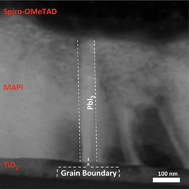Formation, location and beneficial role of PbI2 in lead halide perovskite solar cells†
Abstract
Here we report the investigation of controlled PbI2 secondary phase formation in CH3NH3PbI3 (MAPI) photovoltaics through post-deposition thermal annealing, highlighting the beneficial role of PbI2 on device performance. Using high-resolution transmission electron microscopy we show the location of PbI2 within the active layer and propose a nucleation and growth mechanism. We discover that during the annealing that PbI2 forms mainly in the grain boundary regions of the MAPI films and that at certain temperatures the PbI2 formed can be highly beneficial to device performance – reducing current–voltage hysteresis and increasing the power conversion efficiency. Our analysis shows that the MAPI grain boundaries as susceptible areas that, under thermal loading, initiate the conversion of MAPI into PbI2.



 Please wait while we load your content...
Please wait while we load your content...